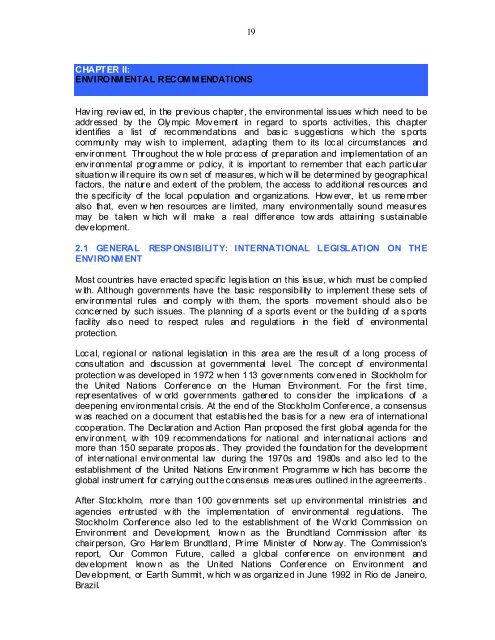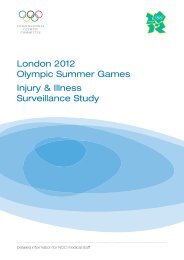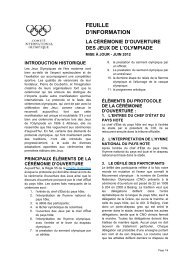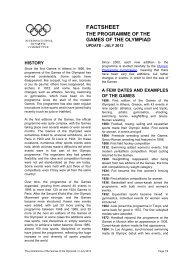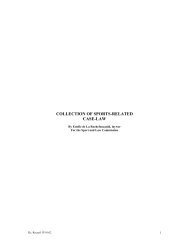MANUAL SPORT ENVIRONMENT
MANUAL SPORT ENVIRONMENT
MANUAL SPORT ENVIRONMENT
Create successful ePaper yourself
Turn your PDF publications into a flip-book with our unique Google optimized e-Paper software.
19<br />
CHAPTER II:<br />
ENVIRONM ENTAL RECOM M ENDATIONS<br />
Hav ing rev iew ed, in the previous c hapter, the environmental iss ues w hich need to be<br />
addressed by the Oly mpic Mov ement in regard to sports activities, this chapter<br />
identifies a list of rec ommendations and bas ic s uggestions w hich the s ports<br />
community may wish to implement, adapting them to its local circumstances and<br />
env ironment. Throughout the w hole proc ess of preparation and implementation of an<br />
env ironmental programme or policy, it is important to remember that eac h partic ular<br />
situation w ill r equire its ow n set of measur es, w hich w ill be deter mined by geographical<br />
factors, the nature and extent of the problem, the access to additional res ources and<br />
the s pecific ity of the local population and organiz ations. How ever, let us reme mber<br />
also that, even w hen resources are limited, many environmentally sound measures<br />
may be taken w hich w ill make a real differ ence tow ards attaining s ustainable<br />
development.<br />
2.1 GENERAL RESP ONSIBILITY: INTERNATIONAL LEGISLATION ON THE<br />
<strong>ENVIRONMENT</strong><br />
Most countries have enacted spec ific legis lation on this iss ue, w hich must be c omplied<br />
w ith. Although governments have the basic responsibility to implement these sets of<br />
env ironmental rules and comply w ith them, the sports movement should als o be<br />
conc erned by suc h issues. The planning of a sports event or the building of a s ports<br />
facility als o need to respect rules and regulations in the field of environmental<br />
protection.<br />
Loc al, regional or national legislation in this area are the res ult of a long process of<br />
cons ultation and discussion at governmental level. The conc ept of environmental<br />
protection w as developed in 1972 w hen 113 governments conv ened in Stockholm for<br />
the United Nations Conferenc e on the Human Environment. For the first time,<br />
representatives of w orld governments gathered to cons ider the implications of a<br />
deepening env ironmental crisis. At the end of the Stoc kholm Conference, a consensus<br />
w as reached on a document that establis hed the bas is for a new era of international<br />
cooperation. The Dec laration and Action Plan proposed the first global agenda for the<br />
environment, with 109 recommendations for national and international actions and<br />
more than 150 separate propos als . They provided the foundation for the development<br />
of international environmental law during the 1970s and 1980s and also led to the<br />
establishment of the United Nations Env ironment Programme w hich has bec ome the<br />
global instrument for c arrying out the c ons ensus meas ures outlined in the agreements .<br />
After Stockholm, more than 100 governments set up environmental ministries and<br />
agencies entrusted w ith the implementation of environmental regulations. The<br />
Stoc kholm Conferenc e also led to the establishment of the W orld Commission on<br />
Environment and Development, know n as the Brundtland Commission after its<br />
chairperson, Gro Harlem Brundtland, Prime Minister of Norw ay. The Commission's<br />
report, Our Common Future, called a global conference on env ironment and<br />
dev elopment know n as the United Nations Conference on Env ironment and<br />
Dev elopment, or Earth Summit, w hich w as organiz ed in June 1992 in Rio de Janeiro,<br />
Brazil.


